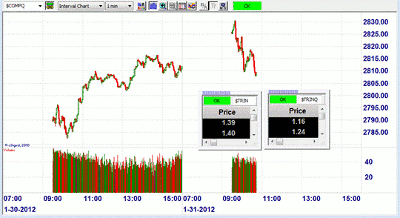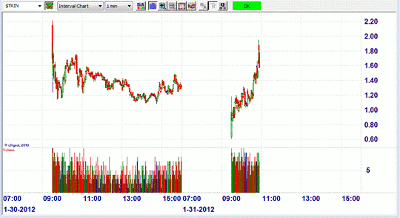Ken Calhoun, founder of Daytrading University, explains how to interpret the TRIN indicator to avoid buying stocks that look to be breaking out but fail to actually make a move higher.
In this article, we'll be looking at the Arms Index (TRIN), developed by Henry Arms. It's a very useful breadth indicator used by momentum breakout traders and is calculated each day as:
TRIN = (Advancing issues/Declining issues) / (Volume of advancing issues/Volume of declining issues)
The TRIN updates every minute and is excellent for trading discipline. When it's "short biased," one should avoid trading to the long side in order to avoid entering false breakouts. Long breakouts in any equity are made only when the TRIN is favorable, or "long biased," for trading entries.
Placing your trades in context of the TRIN can help potentially avoid entering false breakouts. There are two TRINs, one for the Nasdaq ($TRINQ) and one for the NYSE ($TRIN).
Using the Arms Index (TRIN) to Find Directional Market Bias
The TRIN is an inverse indicator, meaning it goes down in value when the market rises (like the VIX). In Figure 1 (two TRINs), you can see that for this particular trading day, January 31, 2012, the market had been selling off. The two TRIN indicators are, therefore, over 1.0, indicating a "short-bias" market.
Note that the two TRIN values will always be different. The main thing to look for when considering a trade is whether they are over or under 1.0?. Since both of these TRIN readings are over 1.0, that indicates selling pressure, and therefore, new entries to the short side are indicated, as are closing out open long trading positions.
To avoid false breakouts, for long entries, it's best to enter only when the TRIN in whichever market(s) you're trading is 0.7 or less, indicating relatively strong buying pressure in the markets. Similarly, the strongest signal for short entries occurs when the TRIN readings are 1.5 or higher.
How to Use the Arms Index (TRIN) for Trading Breakouts
Each morning starting at 9:30 am EST, it's wise to carefully watch the chart and value of either or both TRINs to gauge net buying or selling pressure that occurs during the opening 20 minutes of the market (from 9:30 am EST until 9:50 am EST).
If the TRIN value starts off over 1.0 and rises, then it's best to avoid entering long positions in any equity, regardless of the individual stock chart pattern.
For example, in Figure 2 below, since it was rising throughout the current market session, that told traders to either avoid longs or enter short trading positions.
Similarly, if the TRIN is dropping and/or stays low (under 0.7), then an active trader can look for new-high breakouts in whatever stock they're considering trading on newly-established high prices.
The TRIN rarely pivots strongly during the first hour or two of the market. Instead, it will typically be "uncertain" during the first 5-10 minutes of the day while market-on-open overnight orders are being filled, then it will establish direction during breakouts or breakdowns.
It is during this time, from 9:35 am EST until 10:15 am EST, that the best intraday trades are entered. Similarly, swing traders (those who hold for several days to weeks) can look for potential strength or weakness in the TRIN to determine whether or not to enter new swing trading breakouts.
Being Patient When TRIN Is Near 1.0
The biggest error traders make is taking large stops, being stubborn while trades go against them. The second biggest error is "overtrading" choppy markets and charts.
Whenever the Arms Index (TRIN) is near 1.0, that means the market is at equilibrium and "all bets are off;" e.g., all trading should be avoided. Exceptions can rarely be made, however; for example, if there's high-volume or gap charts, but these are not common. For typical traders, it's best to check the TRIN reading before putting on any trade and only enter new positions if the TRIN is supporting the trade.
When the TRIN is between 0.7 and 1.5, that's a low-volatility time that should not be traded as aggressively as when the TRIN is less than 0.7 (for longs) or over 1.5 (for shorts/long exits).
Using the Arms Index (TRIN) can be a very useful part of any active day (and swing) trader's toolkit of trading indicators, when used properly. It provides immediate market breadth long-short bias that can be used to improve discipline and directional trading entry skills.
By Ken Calhoun, Founder, Daytrading University





















